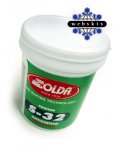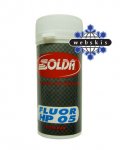
Waxing with Solda for cold snow
Thu, Feb 3, 2011 - By Bert Hinkley
Here we are at the beginning of February. We are looking forward to races like the WHite Pine Stampede, North American Vasa and the American Birkebeiner. All of these races are usually known for cold snow conditions. Unlike snow that is fairly warm (> -6C), where friction can produce a tiny amount of water under the ski, with cold snow (< 14 F or -10C) the thin water layer does not occur. What you get is snow that is like sand, hard and the crystals are sharp. This results in significant friction. It is like skiing down an 80-grit slope.
What you want to do is harden the base with hard wax. SOLDA has figured out how to add synthetic hydrocarbons to harden the basic paraffin waxes. These, when carefully melted into the ski base, reduce the friction factor. SOLDA also has produced powdered synthetic waxes, S20, S30 and S32, that work very well in cold snow. These waxes harden the bases. They are often an excellent race wax by themselves in many cold conditions. More on this will follow. SOLDA has also developed fluorocarbon waxes that enhance glide in cold snow conditions.
Cold snow is often the most difficult to wax for. What follows are suggestions from those who know and ski on cold snow.
In cold snow it is a good idea to harden the bases with F15 Blue (old) /F15 Green (new). Then go with other wax options based on snow and temp and humidity.
 From Michael Mappin in Canmore, Alberta, Canada:
From Michael Mappin in Canmore, Alberta, Canada:
In regards to waxing for cold conditions there are a number of variations we use depending on how old the snow is, or if it is natural or man-made.
1) Man-made: @-15 (5F) and below, we use S30 over F15 Blue (Green in 2010) a lot, and cover with HP06 if really high humidity and stable temperature. If the temperature rises throughout the day, cover with HP05 if high humidity; HP05/S30 mix if low humidity. Sometimes, we encounter surface hoar frost in these conditions; in this case the PowerJet3 is used to cover the powders as a final layer. For long races (over 15km) this should be crayoned on the base and ironed. When cool, repeat and then scrape and brush. First brush out with a fine brass or steel brush. Finish by polishing with a horse-hair brush.
 2) Natural snow: @ -15 (5F) and below, we use S32 over F15 Blue (Green in 2010), and cover with HP06 through most levels of humidity. In these conditions, the HP06 runs warmer, and is replaced by HP05 only at higher temperatures above -10 (14F) to -3 (27F).
2) Natural snow: @ -15 (5F) and below, we use S32 over F15 Blue (Green in 2010), and cover with HP06 through most levels of humidity. In these conditions, the HP06 runs warmer, and is replaced by HP05 only at higher temperatures above -10 (14F) to -3 (27F).
3) Wind-blown natural snow: if the snow is really wind-blown the S20 is the best for cold conditions, but we find this condition very rarely, but when we do, S20 over F15 Blue (Green in 2010) is the ticket.
Justin Wadsworth’s recommendation for Boulder Mountain Tour, Sun Valley, Idaho 2004:
 Pair #1: SOLDA S-30 over SOLDA HC28 (or S-20) and F-15 Violet (or F-15 Violet and Blue)
Pair #1: SOLDA S-30 over SOLDA HC28 (or S-20) and F-15 Violet (or F-15 Violet and Blue)
Pair #2: SOLDA HPO5 over S-30 (base of SOLDA HC28). Make this pair your first choice if the humidity is on the medium to high and temperature is higher than the forecast.
Low cost alternative:
One or two layers of SOLDA F-15 Blue/Green or HC.1 Blue (over 1 layer of F-15 Violet or HC.1 Violet).
I share this for all who want to know more about their own skis and waxing. Cold Sun Valley snow requires colder wax than you might think. I have also found that certain areas have snow that skis colder than the temperatures read. McCall, Idaho is one of these places.
